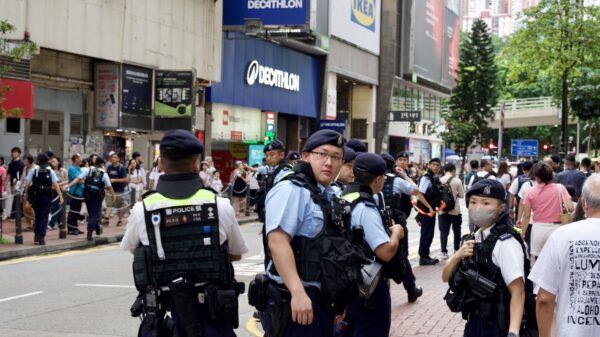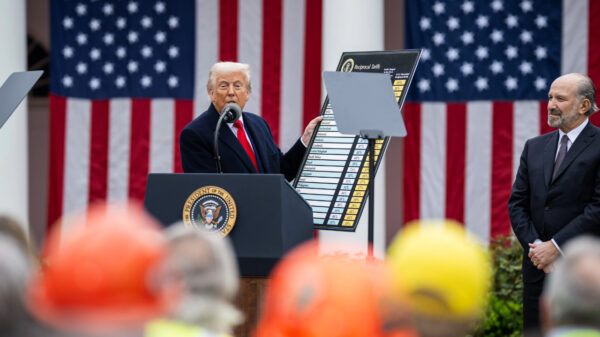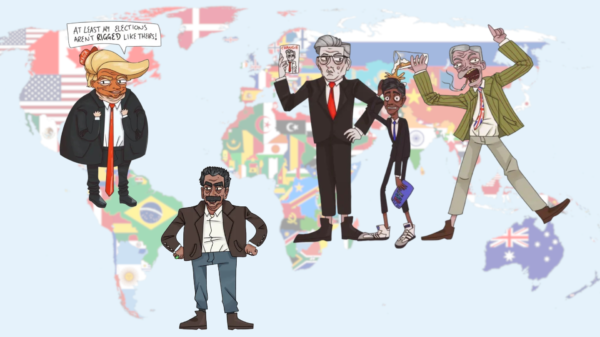Comment editor Fintan Hogan questions the narrative that a rising China should be ‘cut out’ of the international system. Is Beijing really destined for global leadership?
The Atlantic asks “What kind of superpower will China be?”. A bestseller is entitled ‘When China Rules the World’. The Brookings Institute reports on “China’s grand strategy to displace American order”. Underlying it all, the presumption that China will continue to rise. Regional power, superpower or hegemon – everyone agrees that it’s a matter of if, not when.
And with fair reason. Since the death of Chairman Mao in 1976, the population has increased by 50%, Gross Domestic Product (GDP) by 11,500% and the value of exports by 50,000%. By almost any measure, China has been the post-communist success story. Red China became Reddish China; the USSR fragmented into conflicting post-Soviet states.
Up, up and away
‘Open door’ reforms initiated by Deng Xiaoping took hold in the 1980s. Trade liberalisation, the relaxing of private capital regulation and the state fostering the market was a step-change from Maoist rule. The GDP per capita growth rate only dropped below 4% three times between the 1978 reforms and the turn of the century. In 1997, the IMF asked ‘Why is China growing so fast?’. Little did they know what was coming.
Changes were supercharged by accession into the World Trade Organisation (WTO) in 2001. This both created a market for foreign capital investment into China and exploded the demand for exports out of it. Like a boulder pushed off a cliff, China’s economy picked up speed at an exorbitant rate. While GDP per capita increased five-fold between 1980 and 2000, it increased twelve-fold in the two decades after. The Chinese share of global exports has risen from 4% to 15% since the joining the WTO. 800 million people have been lifted out of poverty in 40 years. ‘Meteoric’ appears an understatement.
Bringing in the beast?
In 2000, President Clinton pondered: “Will it be the next great capitalist tiger, with the biggest market in the world, or the world’s last great communist dragon and a threat to stability in Asia?”. At the time, the consensus was that trade would ‘tame’ the tiger. Now, many in the ‘western World’ believe that they have paid for the excesses of the Chinese Communist Party (CCP); that trade fostered a Chinese dragon hunting for nothing short of world domination.
The response, particularly in the US, has been reactionary. America’s protectionist slide under President Trump has, if anything, been redoubled under Biden. Democrats and Republicans can’t agree on much – except that China is big, red and scary. But this fatalist logic is questionable. China’s rise is neither certain, nor is a ‘cutting out’ the appropriate response.
Inexorably? Really?
If the last decade has taught us anything, it’s that no one can predict the future with any accuracy. But China is not the monolithic, inevitable power it is often portrayed as in the media.
2022 was the first time in six decades that deaths surpassed births, heralding an incoming crisis. India is expected to become the most populous country before 2023 ends. This has been a decade of U-turns on social policy from Beijing: the one-child policy was scrapped in 2016, the allowance increased to three in 2021 and a whole raft of subsidisations making child-raising more attractive introduced. Yet China’s ‘demographic window’ has abruptly slammed shut.
The UN-forecast for the ‘dependency ratio’ is expected to drop from around 10:34 in 2020 (10 dependents per 34 working adults) to 10:25 by 2050. This will present demographic challenges which the CCP has not yet faced, including the higher cost of labour, rising pension and healthcare burden and a less mobile labour force. No matter what happens, China will no longer enjoy the cheap, well-educated and seemingly endless labour supply it once did.
Free trade did not, as Clinton hoped, inspire a free press. Government enforcement has – remarkably – even largely bottled the genie which is the internet. Unfavourable stories and ideas are suppressed by an effective surveillance state. At least – for the most part. Recent ‘zero-Covid’ protests were some of the largest in mainland China since Tiananmen Square. Former leader Hu Jintao was escorted out of the Party Congress despite obvious confusion, shattering the CCP’s annual stage-managed set-piece. The key policies of that Congress – continuing strict Covid-19 rules – were abandoned less than six months after they were announced with such pomp and ceremony. These are not the hallmarks of unchallenged authoritarian rule. Post-materialist concerns like civil liberties, minority rights and democratic choice can only be supressed by the Chinese state for as long as economic growth stays high and inequality stays low. This delicate balance is not going to last forever.
Finally, it’s not the case that the international dominos are going to fall perfectly into place. China has to fight against the network of alliances and safeguards that the US-led order has had 75 years to erect. India, Japan and South Korea are powerful checks on any regional territorial aspirations. China has been aggressive in the South China Sea, yes, but scarcely more than atolls and open water have been ‘taken’. China practices ‘war games’ around Taiwan to posture militarily, but America’s policy of ‘strategic ambiguity’ leaves the threat of war hanging over President Xi’s head if he ever tries an amphibius assault on the island. The ‘belt and road’ network of international investment has built a web of Sinophilic states in the near East and Africa, but these are minor regional actors at best. The Beijing-Moscow axis has been weakened by Putin’s invasion. The EU has an appetitive for Chinese money, but not for its neutrality over Ukraine or unfair standards of competition.
The only way for China is up – but that doesn’t mean they’re going all the way to the top. The fear of an inexorably rising China often leads US foreign policy, just as Sparta was concerned with a rising Athens. But the established powers still have assets that Beijing can only dream of. Friends, funds and fortune don’t come on-demand.
As such, the way to deal with China should not be to presume either omnipotence or naivety on Beijing’s behalf. They are not the shackled capitalist tiger, nor the threatening communist dragon, but a red panda – only so far up the tree.
CCP choices
This doesn’t mean that China is passive or friendly. Territorial and aggressive if provoked, the demographic, political and international pressures on President Xi will make China more unpredictable. Suffering from a protracted Covid-19 economic downturn and the resultant civil unrest, Chinese leadership is under enormous domestic pressure to re-energise.
This may result in a more provocative foreign policy. Beijing’s grip on Hong Kong has tightened in the last few years. Taiwanese invasion fears are rising as the CCP heightens talk of ‘One China’. ‘Wolf warrior’ diplomats attack any attempts to advise, caution or threaten by democratic states. China and India compete over mountainous borders and the Indian Ocean.
Slowing down from its heady ascent, China may see now as the time to dig its claws in, before other rising powers like Indonesia begin to properly pursue their own regional claims. It remains to be seen how assertive Beijing will be in expanding their influence considering the looming reality that ‘peak’ growth has been and gone. Now may be the time when China has the most relative influence in South East Asia, before other regional powers race to catch up.
Policy response
But now is not the time to freeze China out. Hawks present China as an existential threat to the ‘western’ way of doing things. Inspired largely by a fear of US hegemony slipping, protectionism and provocation appear the order of the day for American politicians in particular.
It’s true that integration into the UN and WTO has not brought all the dividends that optimists hoped for. China did not rush to democratise at the first whiff of American cash. But leaders of all stripes should remember that influence is not a zero-sum game – what’s worse for China is not necessarily better for Europe or America. Institutional inclusion has constrained President Xi and his predecessors from their worst excesses.
A China with no stake in international trade or diplomacy is a far more dangerous China, especially considering the rising internal pressures on the CCP. Taking the ‘handrails’ off of China’s foreign policy by initiating war-games, tariffs and sanctions will cause this pressure to explode outwards. In these conditions (when, seemingly for the first time, the CCP doesn’t quite know what to do) keeping an open dialogue and some mechanisms of accountability is vital. Because the Chinese value their seat at the negotiating table so highly, they don’t want to smash up the chairs.
Of course we should not be free market fundamentalists. Concerns about human rights violations in Xinjiang’s Uyghur Autonomous Region need to be investigated. Specific, targeted sanctions on certain products like cotton may be an appropriate response to not allow European consumers to unwittingly profit from forced labour. Huawei technology may need to be removed from sensitive infrastructure if there are concerns over potential state influence. Industries like semiconductors, where China and Taiwan have a near-stranglehold on the market, could benefit from some reshoring in case of a crisis.
But greater ambitions of ‘economic decoupling’ are nothing short of isolationism. President Trump was correct to assert that the US should not – cannot – rely on China for everything. But to assert that “they take our money and they spend it on building aeroplanes and building ships and building rockets and missiles” is misleading. Networks of credit and investment reach worldwide – US money is not an IV drip keeping the Chinese economy alive. Everyone pays for everyone’s stuff. While tied into global institutions like the UN and WTO, China has less incentive to invest in a massive military build-up or threaten democratic neighbours. Decoupling would be about as expensive for the US as for China and create a threatened, pariah state which has every reason to fear American influence.
President Nixon was correct to assert that “taking the long view, we simply cannot afford to leave China forever outside the family of nations, there to nurture its fantasies, cherish its hates and threaten its neighbours”. We should not go back to the political and economic self-destruction of a bipolar world system. An outcast China may have less economic clout in absolute terms, but there are reasons to suspect that the price is not worth paying. Weaker checks on internal human rights abuses, a closer Beijing-Moscow alliance, a more assertive foreign policy and less incentive to compromise on existential issues like climate change would make the world a less safe place. As China’s climb begins to falter, it’s important that we keep them inside the system. The red panda can be vicious when backed into a corner.
















